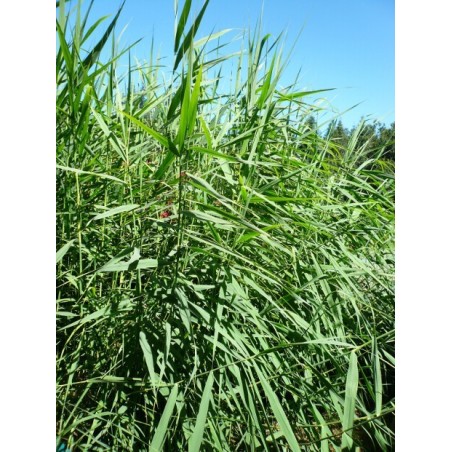



Phragmites australis - Common Reed
2 rhizomes
Seasonal Product
Available from November to March
-
Phragmites australis should not be confused with other ornamental grasses such as Bamboo, Pampas Grass, and Miscanthus
This is a lake plant that grows in marshes and on the banks of bodies of water
Unlike previous grasses, it lives with its feet in water
Like Bamboo with its rhizomes and like Pampas Grass with its seeds, it is a colonizer
However, it will never venture outside the wet zone
You can therefore use it without fear of seeing it invade the entire garden for the decoration of a pond or the purification of water if you own a private treatment plant for your wastewater
(used for this purpose by municipalities which practice wastewater lagooning)
Reed grows in spring from a rhizomatous stock, forming dense, tall colonies of magnificent bluish-green foliage until late autumn
In early summer, an inflorescence appears at the top of the stems, burgundy in color, shiny in appearance, quite decorative
Phragmites australis loses its leaves in November
Its culms die in winter and must be cut to ground level before spring to leave space for new shoots
They are perfect for making mulch and decompose quickly
Interesting plant for its many uses, besides ornamental: stabilizing the banks, a source of biomass fuel, insulation, raw material in crafts (paper, baskets, etc.), water purifier (lagoons, biological treatment plants) culinary (young shoots used as bamboo, sweet sap extracted from young stems and reduced by cooking)
Phragmites australis is a medicinal plant with the following properties: Anti-asthmatic, Antiemetics, Antipyretic, Antitussive, Depurative, Diuretic, and Stomachic
Its inflorescences are used to produce a magnificent green color in dyeing wool and silks, provided they are harvested at the optimal time
(the pollen contains the coloring principle)
-
| Jan | Feb | Mar | Apr | May | Jun | Jul | Aug | Sep | Oct | Nov | Dec | ||
|---|---|---|---|---|---|---|---|---|---|---|---|---|---|
| ➔ | ➔ | Z5 | |||||||||||
Very easy to grow
Pant Common Reed from November to March, in a soil that is always humid and can possibly be soggy or covered with water during summer, in full sun
The plant will settle quickly to produce impenetrable beds
During winter, when the stems dry out, cut them for one of the uses described above, or destroy them with a brush cutter, leaving the waste as mulch
You might also like
Payment :
PayPal < 150 €
Check < 850 €
Bank Wire > 149 €
Thank you for your kind understanding